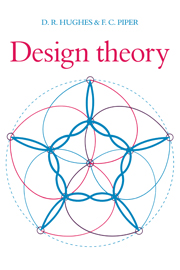1 - Basic concepts
Published online by Cambridge University Press: 08 January 2010
Summary
Introduction
This chapter is the introduction to structures and designs and, while it is completely elementary, it is essential to the rest of the book. Section 1.2 contains the basic definitions. In Section 1.3 we then give a number of examples. We begin by listing some small carefully chosen ones to illustrate the meanings of the earlier definitions but then go on to examples based on projective and affine geometry. Obviously knowledge of classical geometry will help the reader to follow and understand these examples, but we have tried to make our explanations as full as possible and to make the entire chapter self-contained. Nevertheless the importance of finite projective and affine geometry to design theory cannot be overemphasised and we include some excellent references for further reading. In Section 1.4 we return to definitions and results about arbitrary structures, in particular relating a structure to others which can be constructed from it or from which it can be constructed. Section 1.5 studies the incidence matrix of a structure, already introduced in Section 1.2, and uses it to prove a number of basic theorems: Fisher's Inequality and properties of square structures and symmetric designs in particular. Polarities are introduced and the incidence matrix is exploited to prove a number of their basic and important properties. In Section 1.6 the notion of tactical decomposition of a structure is introduced, Block's Lemma is proved, and applications to automorphism groups (in particular the Orbit Theorems) are deduced. Resolutions and parallelisms are briefly introduced as well. Section 1.7 contains a brief discussion of graph theory and some of its connections with the theory of structures and designs.
- Type
- Chapter
- Information
- Design Theory , pp. 1 - 51Publisher: Cambridge University PressPrint publication year: 1985



